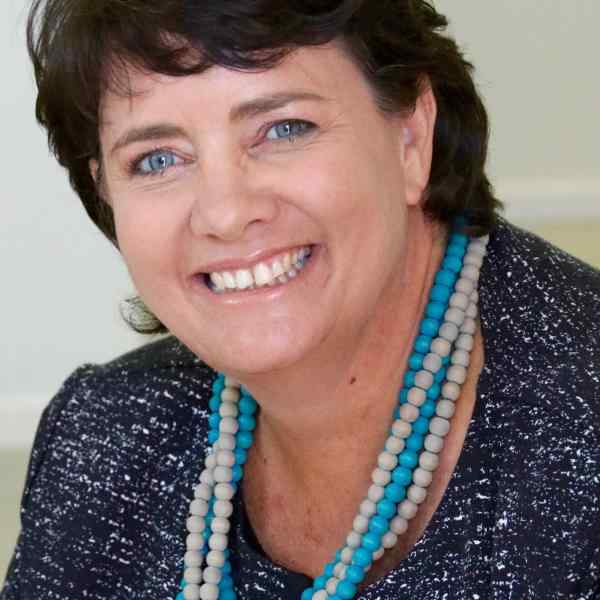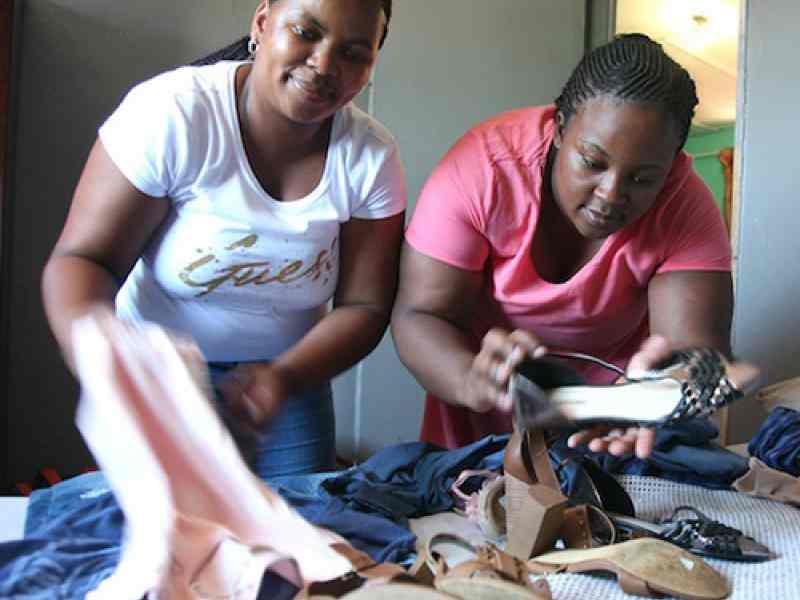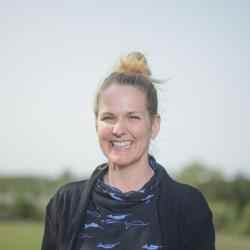Introduction
Tracey is economically empowering the most marginalised unemployed mothers and fathers in township communities of South Africa. Using excess stock from retail companies, she creates a fluent supply of merchandise which she merges with a holistic program that focuses on creating self-reliance as a fundamental component for lifelong income generation. In doing so, she enables the unemployed to emerge successfully from a life of poverty.
The New Idea
Tracey has created a comprehensive infrastructure for unemployed mothers and fathers in South African township and peri-urban contexts to start and be successful in generating their own incomes. She does this by first, providing access to best quality merchandise sourced directly from South Africa’s top retail companies, which the women and men are able to start trading with. She then puts them through an intensive process, through which she is able to address critical areas of physical, mental and social well-being, through two years of mentorship, life and peer-coaching, and business and technical skills, allowing women and men to take charge of their own growth. This head-heart-hands approach differentiates Tracey’s program from traditional business and entrepreneurship programs aimed at livelihood and job-creation in South Africa, which often only focus on the technical skills, as opposed to addressing the contextual inequalities the participants come from. Tracey has proved this approach is replicable, with her expansion into early childhood education centres, where she provides informal child care centre owners with business-in-a-box, support and training, and school-in-a-box models to create, for the first time, sustainable centres providing quality early childhood education within South African townships.
At the same time, Tracey continues to offer value to private sector stakeholders to engage with, and contribute to poverty alleviation in their own contexts and communities. She offers a platform for retailers to address the burgeoning problem of retail waste – high quality products that still do not find a space in the market, which are cyclically disposed off in the landfill. With this entry point, Tracey starts engaging companies to determine how they can support their own employees, many from the townships themselves, to ensure that the formal sector meaningfully contributes to lifting them out of poverty.
Tracey wants to ensure that all her interventions successfully arrests the poverty cycle, and creates sustainable pathways for people to emerge out of poverty. She has contextualised and integrated the Poverty Stoplight tool both within her own scope of interventions, as well as externally, with the citizen and private sector partners, through which she equips program participants to evaluate themselves on a range of indicators on poverty and wellbeing. This enables them to design their own roadmap out of poverty, and course correct when they find themselves falling behind. Accompanied with critical training programs covering life, business and finance skills, she equips organisations to create empathetic interventions for their employees and their beneficiaries.
The Problem
In South Africa, the unemployment rate amongst people below 29 is 50% in townships compared to 25% outside townships. Amongst young single mothers, the unemployment rate is even higher making it difficult for them to provide a future for their children: 60% of single mothers are unemployed and few have access to training opportunities and job experience required to be hired into the formal sector. With less than 50% of fathers providing any emotional or financial support, these women usually eke out a living trading informally in the townships but low education levels, large skills deficit, and poor access to finance, increase the struggle of these informal traders to take themselves out of poverty.
In this context, public and private sector emphasis has been on entrepreneurship as an alternative for formal sector jobs. Correspondingly, several large governmental and citizen sector initiatives have invested in building entrepreneurship development programs across the country. However, the success rate has been very low – only 5-10% of small business succeeds annually. This could be because even if unemployed women and men from the township sign up for training, much of enterprise and skilling programs focus solely on business skills, without addressing the context of the participants. In the past, black workers in townships were only allowed to engage with low-skill work. When apartheid ended, there was a parallel widespread consensus on the symbolic denouncement of vocational training and education, leading to the shut down of official apprenticeships across trades and skill areas. It is only in the last ten years that such training is re-emerging.
Further, unlike other, more entrepreneurially-oriented ecosystems, inter-generational role modeling is also not available, inhibiting transfer of skills. This could possibly be the reason why the Global Entrepreneurship Monitor report in 2016 shows that the nascent level of entrepreneurial activity is very low in South Africa in comparison to other developing countries.
Meanwhile, high-end retailers routinely find themselves confronted with the problem of excess stock of all kinds of products. Between 1-2% of retail sales is considered waste which includes in-store damages, customer returns and end of season merchandise. When clothing products are returned for small defects, the retailers do not have the capacity to send it back to the manufacture. Repairing it themselves would call for investment of in-house skills which is also expensive. Very often, at the end of each season, retailers are faced with a choice: to send the excess stock to the landfill or to donate the excess stock. If they chose to donate, then donations were made to a few charities, particularly orphanages. However, this was done in a haphazard manner, with the products not meeting any specific need of the children, and mostly left in storage, or being used by staff of those institutions. More often, the merchandise ends up in the landfill.
Finding sustainable income generation opportunities for women and men in townships is becoming more and more urgent in the country. At the same time, the amount of re-saleable product getting wasted is also becoming a mounting concern. Tracey saw a way to bridge this gap. Considering that entrepreneurship is not a cultural norm, Tracey’s focus is on ensuring that they can easily and quickly start a simple trading business, or a micro-franchise business, that doesn’t require them to have the required social capital and business skills from scratch, but would offer them lifelong opportunities to earn sustainable incomes.
The Strategy
Tracey’s strategy is modelled around making business and entrepreneurship skills accessible for a populace that had been systematically alienated from them before.
She understood this early on, in her first pilot with 10 women in 2010. At that time, she had secured her first big retailer who was ready to donate their excess stock to her. In the engagement with the women though, Tracey realised that she needed to break down ‘entrepreneurship’ to its simplest form - to the act of buying and selling, thereby making it accessible and achievable. Further, she understood that women need to start the process of trade at the beginning, and not after the completion of a particular training program. It is from this insight that Tracey was able to build all the different elements that constitute the Clothing Bank.
The first important element comes from Tracey’s partnerships with major retailers in the country. Through these partnerships, she has mobilized a constant stream of donated merchandise from high-profile retailers in the country. The goods that span clothing, beauty products, jewellery, appliances and other non-perishable items, are stocked in factories across the country, where they are sorted and used to support formal and informal trading in the townships. The Clothing Bank takes in 400 new mothers a year, and starts them off with an in-kind loan of R600 (USD 50). Once they complete their initial training of two weeks, the mothers begin to buy merchandise from the Bank at significant discounts (20% of the listed price). They are then able to mark it up to 150% (still less than 50% of the listed price), and are expected to report earnings in profits up to R4,000 (USD 330) a month. For many of Tracey’s beneficiaries, the ability to month on month generate their own personal wealth, and save it for the future is a powerful moment of self-belief.
Tracey saw the importance of expanding such moments from economic to the social and emotional spaces. Thus, she scaffolds the practical business training with knowledge, healing and life coaching, and personal development. The women have also got access to mentors: a network of trusted business advisors set up to support their growth as entrepreneurs. As women begin to make critical changes in their lives, such as putting their children in good schools, or getting rid of an abusive partner, their self-belief grows. As Tracey started working with the women, she observed how their success resulted in the success of their families, and the wider communities. Towards sustaining this, Tracey has in 2017, started selecting 10% of the women, those who are successful entrepreneurs and can be role models in their communities, to become part of an Ambassador program. These women are given training in servant leadership, after which Tracey hopes they will be able to continue rippling out self-affirming moments in the community at large. Equipped with a decontextualized version of the two-year training program she sees these women delivering these courses in their communities, allowing more women and men to access the socio-emotional support offered by them.
As Tracey began to work with women, she also started seeing the negative impact that absent fatherhood had on the families at large. When Tracey began to receive slightly defective appliances from one of her retail partners, she saw the opportunity to work with men. She identifies unemployed fathers in the community to go through a similar immersive process like the mothers, to learn how to repair the appliances, and trade them in the township market. She couples these courses with parenting courses as well as a mencare program. From there, she sets them up to provide high-demand township repair services, which allows them to find purpose and feel like contributing members of society. Just like the women, she hopes to see the unemployed fathers begin to take responsibility for their families, and start becoming positive male role models for young people in the townships. From 2016, she has worked with 50 men and is looking to grow this to 200 by end of 2019.
As she continued offering opportunities for self-employment, some of her participants started using their new found wealth to put their children in good schools. These schools were usually outside of the suburbs, and women spent significant amounts of money on transport for this opportunity. At the same time, Tracey observed informal child care centre owners struggling to make businesses work from scratch. Tracey saw the need to de-risk the entrepreneurial process. Having learnt the importance of holistic support from her work with traders, Tracey decided to offer a well-designed system that would be easy for people to follow, so that success in enterprise could be attainable beyond the few with natural aptitude.
Tracey thus identifies existing informal child care centres in the townships, and offers them the opportunity to re-brand, and create better infrastructure for high quality child care. She does this by following a social franchisee approach, creating a centralised process of support with tools and materials and training, allowing the franchisees to only worry about finding the customers, and ensuring consistent service. Along with regular training, peer-to-peer connections and mentorship, she offers a business-in-a-box model that has readymade templates for franchisee owners to follow to help them run the school efficiently. Coupled with the school-in-a-box which engages teachers and school owners on key 21st century skills including empathy and collaboration, Tracey has ensured that their wards, for this generation and next, will have the best possible start to their education.
Tracey’s strategy thus spans education, employment and income generation and as she grows, she sees her hubs in Johannesburg, Cape Town, Durban, East London and Paarl, as driving impact across these critical indicators. Since her launch in 2010, Tracey has trained over 2500 women who have collectively generated profits in their businesses of over R100 million (USD 8.3 million). However, seeing that this was not helping her convincingly determine if her participants were moving out of poverty, in 2014 Tracey bought, and contextualized the Poverty Stoplight tool to South Africa. This methodology provides the participants with clear line of sight with what actions they need to take to eradicate poverty in their families and creates volition. It uses 50 indicators where green = not poor, orange = poor and red = very poor. Tracey and her team visit each participant (unemployed mothers and fathers, as well as care centre owners) and family at the start to assess the baseline, and then work with each one to set goals for the family to work towards eradicating poverty. Metrics are then reassessed after 12 and 24 months and a statistical sample of graduates is done one year after they leave the programme. Tracey discovered that 80% of the graduates are still trading one year on. Further, on the poverty stoplight, typically, beneficiaries join the programme with 30 greens, 15 oranges and 5 reds and leave with 45 greens, 4 oranges and 1 red, an indication that they are successfully moving themselves and their families out of poverty.
Seeing the success of the tool, Tracey felt the need to share it with other organisations, so that they could gain visibility on how they are truly alleviating poverty as well. Through the Poverty Stoplight office, that she was instrumental in setting up, she has engaged more than 30 other citizen sector organisations, who are all using the localised version of the tool to understand and report on their own impact. Further, she has started to engage with companies, to equip them with visibility on how they can participate in combating poverty of their own employees. In 2017, she worked with a well known food retail chain to roll out the Poverty Stoplight assessment with their entry-level employees (many from the townships), following which they identified the need for them to manage their personal finance better. Based on this, she equipped them with a course called Me and My Money, derived from one of her own modules. She hopes that through this methodology, she can reach more companies in the private sector, who can start empathetically engaging with their employees, once they’ve realised the circumstances they come from, helping them see their own roles in helping their employees move definitively out of poverty.
Tracey is consistently keeping one eye on the sustainability of her vision. From an enterprise perspective, the Clothing Bank is 80% self funded from the revenues from the informal traders buying from the factories. While she has funding for the short-fall, she hopes that it will get to 95% self funding by 2021.
The Person
Tracey began her journey as a chartered accountant at one of South Africa’s biggest retailers, Woolworths. She spent 9 years at Woolworths, climbing the corporate ladder, when at age 40 she realized that it was not satisfying to her anymore. In 2008, she quit without a plan. In the year following, she volunteered in a few places, but found herself enjoying teaching and mentoring the most. Around that time, she also connected with an old friend (and now co-founder) Tracey Gilmore, who had been experimenting with creating income generation opportunities through artisan collectives with women in the Western Cape. In the course of discussing the struggles and challenges, Tracey recalled her experience at Woolworths, where she witnessed first hand, the dilemma of retailers about their excess stock. At the same time, she remembered her domestic help, a natural trader, who made a good amount of money selling Tracey’s second hand clothing. Putting the pieces together, Tracey teamed up with Tracey Gilmore, to set up the Clothing Bank in 2010.
Once Tracey began the program, and really understood what poor women in South Africa were facing, she was able to move beyond her presumptions, to design a programme that had real impact. This was the genesis of the two year training program, during which they deliver more than 1000 hours of training towards building life skills, financial discipline and business skills. She set up an army of life coaches, who could support the women emotionally to keep them focussed on persevering towards their goals. Further, she brought on experienced business mentors who provide practical advice and monitor their finances to ensure they build financial resilience. She has counsellors who provide psychological support when they get knocked down. This training program has become the bedrock of their further work - having understood the problem of absentee fathers by their impact on the women and their families, Tracey developed the model to engage unemployed fathers. Seeing the need for the women to engage in business opportunities without encountering the associated challenges: market visibility and competitiveness, she developed GROW, the ECD micro franchise accelerator, allowing women to safely engage in running profitable, high quality schools. Along with this, she also set up 3 others: mobile coffee, pizza delivery and nail and beauty salons. While the first two failed due to higher infrastructure needs, the nail and beauty micro franchisees were spun off, and ultimately became part of a larger chain of salons under its own brand.
At every level Tracey is looking for the next opportunity to see how she can create a way for South African men and women to emerge from poverty, and is unafraid to take risks till she finds the next big opportunity. For instance, on an unrelated trip to Paraguay, she met Martin Burt the founder of the Poverty Stoplight methodology. Seeing the power in it, Tracey decided to pilot it in South Africa. After contextualising and using it herself for three years, she saw immense value in making it available for the wider citizen sector - including other organisations who are working in the area of poverty alleviation.
From Tracey’s own admission, she doesn’t like to have five or ten year plans. She believes that this inhibits her ability to see opportunities as they arise. She strives to live life in the present moment and to challenge herself daily to develop and create solutions that will enable poor South Africans to eradicate poverty (in the broader sense of the word). She sees this as her core life mission and as a daily responsibility to develop solutions that do this holistically and responsibly.

 Tile image
Tile image


